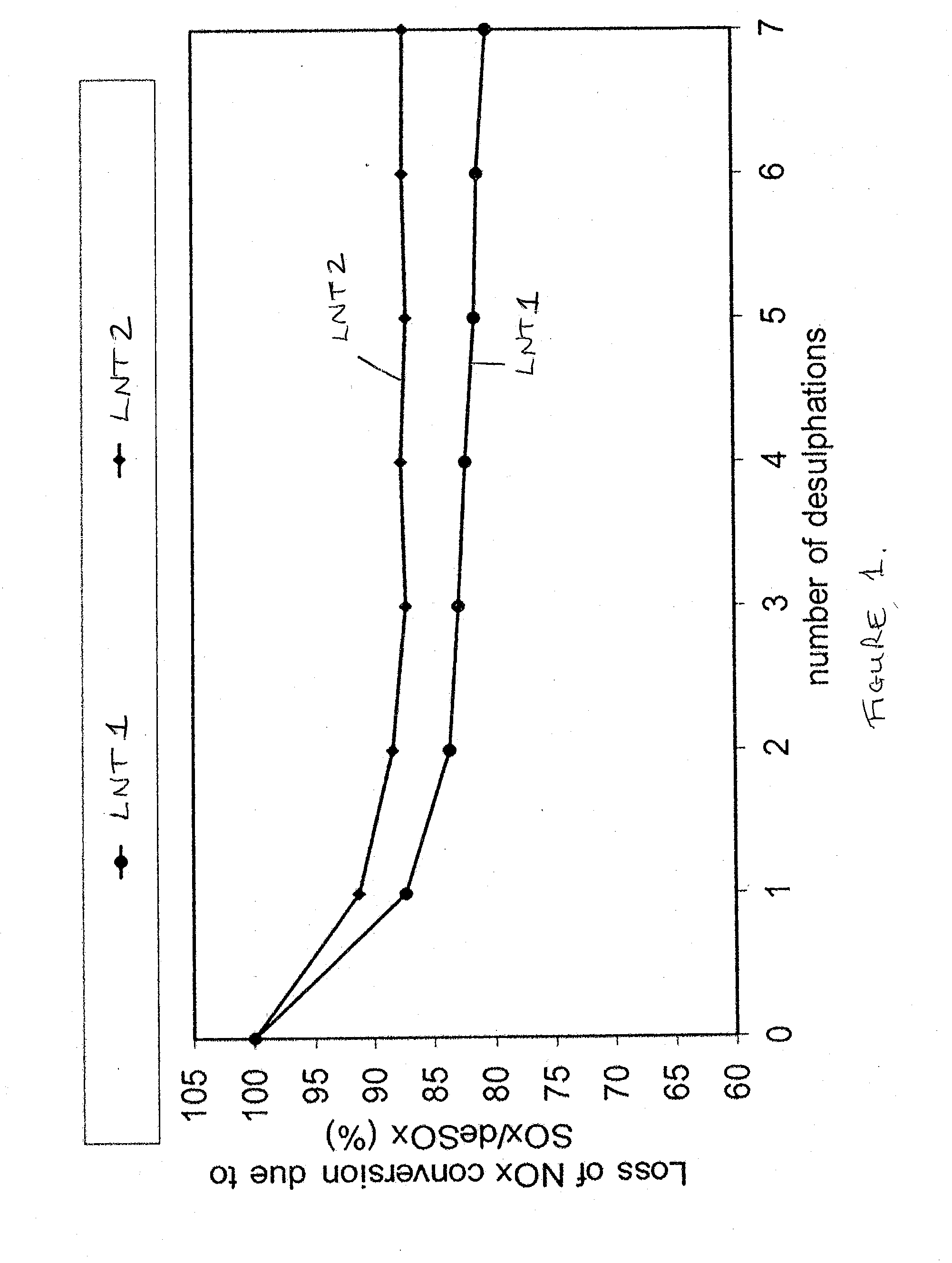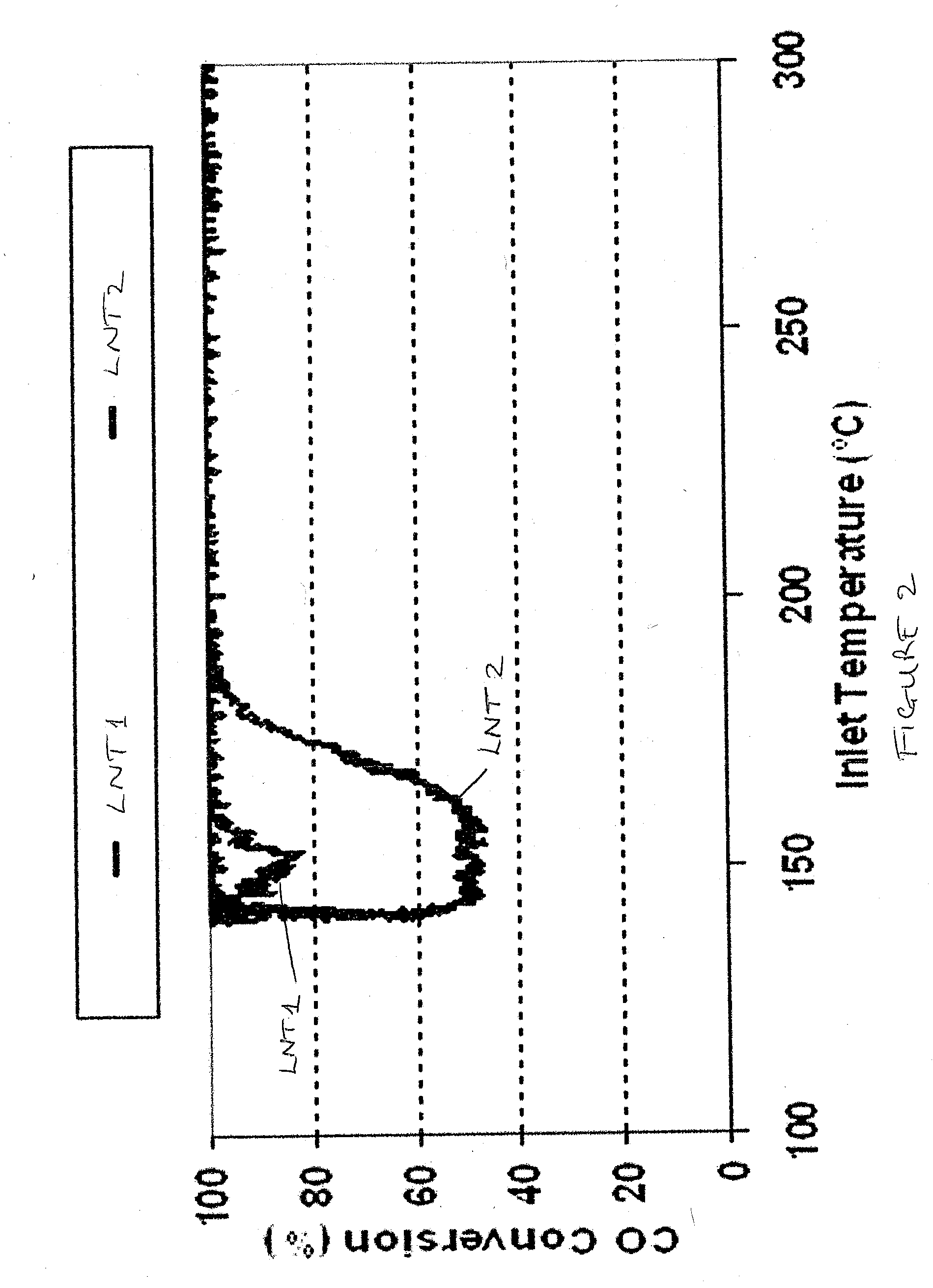NOx TRAP
a technology of nox traps and traps, which is applied in the direction of electrical control of exhaust treatment, physical/chemical process catalysts, and separation processes. it can solve the problems of traps that may present difficulties, not believed, and the difficulty of nox storage and conversion, so as to improve heat generation efficiency, slow temperature propagation through the length of nox trap substrates, and the effect of releasing trapped sulphur
- Summary
- Abstract
- Description
- Claims
- Application Information
AI Technical Summary
Benefits of technology
Problems solved by technology
Method used
Image
Examples
example 1
Lean NOx Trap Formulation
[0035]A 400 cells per square inch flow-through cordierite substrate monolith was coated with a two layer NOx trap formulation comprising a first, lower layer comprising 2 gin−3 alumina, 2 gin−3 particulate ceria, 90 gft−3 Pt, 25 gft−3 Pd and 800 gft−3 Ba and a second layer comprising 0.5 gin−3 85 wt % zirconia doped with rare earth elements, 10 gft−3 Rh and 400 gft−3 ceria sol. The first layer was coated on the virgin substrate monolith using the method disclosed in WO 99 / 47260 followed by drying for 30 minutes in a forced air drier at 100° C. and then by firing at 500° C. for 2 hours before the second layer was applied and the same drying a firing procedure was repeated. This NOx trap was labelled LNT1.
[0036]LNT2 was prepared using an identical procedure except in that 400 gft−3 ceria sol was also added to the lower layer formulation.
example 2
Synthetic Catalytic Activity Test (SCAT) repeat SOx / deSOx Test
[0037]A core was cut from each of LNT1 and LNT2 and each core was tested in turn using on a Synthetic Catalytic Activity Test (SCAT) apparatus using the following conditions:
[0038]1) Cycle between 300 seconds lean / 20 seconds rich at an inlet temperature of 350° C.[0039]5 cycles with no sulphur to evaluate clean NOx performance; and[0040]5 cycles with sulphur to sulphate sample to 2 g / litre
[0041]2) Desulphate at 500° C. for 5 minutes[0042]Cycle between 50 seconds rich / 10 seconds lean
[0043]3) 300 seconds lean / 20 seconds rich at 350° C.[0044]5 cycles with no sulfur to evaluate desulfated NOx performance; and[0045]5 cycles with sulfur to sulfate to 2 g / l
[0046]4) Repeat
[0047]The gas conditions used are set out in Table 1.
TABLE 1LeanRichLeanRichdesulphationdesulphationLength (secs)300201050NO (ppm)100200——CO (%)0.03212CO2 (%)610610C3H6 (ppm)501700501700H2 (%)00.400.4O2 (%)111.561.5H2O (%)12126.612Flow rate47394739(l / min)
[0048]T...
example 3
NOx Trap Lower Layer CO Oxidation Activity
[0049]Substrate monoliths coated with the lower layers only of LNT1 and LNT2 following drying and firing prepared as described in Example 1 were aged at 800° C. for 5 hours in 10% H2O, 10% O2, balance N2. The substrate monoliths were each tested on a laboratory bench-mounted 1.9 litre Euro 4 Diesel engine by removing an existing NOx trap and replacing it with the LNT1 (lower layer) or LNT2 (lower layer) substrate monoliths.
[0050]An engine speed of 1200 rpm was selected and the engine torque was varied to achieve a desired catalyst inlet temperature. The evaluation started with a catalyst inlet temperature of 350° C. The engine torque was adjusted to ramp the inlet temperature down to <150° C., sufficient to achieve carbon monoxide oxidation “light-out”. In practice this was done by reducing the engine torque from 100 Nm to 5 Nm over 10 minutes. Following “light-out”, the engine torque was ramped back up at a rate of approximately 7° C. / min t...
PUM
| Property | Measurement | Unit |
|---|---|---|
| Fraction | aaaaa | aaaaa |
| Time | aaaaa | aaaaa |
| Time | aaaaa | aaaaa |
Abstract
Description
Claims
Application Information
 Login to View More
Login to View More - R&D
- Intellectual Property
- Life Sciences
- Materials
- Tech Scout
- Unparalleled Data Quality
- Higher Quality Content
- 60% Fewer Hallucinations
Browse by: Latest US Patents, China's latest patents, Technical Efficacy Thesaurus, Application Domain, Technology Topic, Popular Technical Reports.
© 2025 PatSnap. All rights reserved.Legal|Privacy policy|Modern Slavery Act Transparency Statement|Sitemap|About US| Contact US: help@patsnap.com


